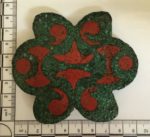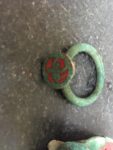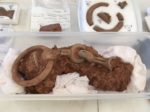 The first Celtic chariot burial ever found in Wales has been discovered in a Pembrokeshire field by a metal detector hobbyist. When floods made his usual haunt impassable this February, Mike Smith surveyed a new site in southern Wales. (The exact location is being kept secret for its protection.)
The first Celtic chariot burial ever found in Wales has been discovered in a Pembrokeshire field by a metal detector hobbyist. When floods made his usual haunt impassable this February, Mike Smith surveyed a new site in southern Wales. (The exact location is being kept secret for its protection.)
“My first find was a Celtic horse harness junction piece,” said Mike. “When I found it my friends said I would never top it, but the next day I went back and found the rest…”
As Mike dug down eight inches into the soil he found other decorative pieces, including bronze bridle fittings, a brooch and the handle section of tools.
Though they were green from corrosion, the bronze pieces were covered in bright red enamel decoration which had not faded with time.
 The small metal objects weren’t the only thing at the site. Smith’s metal detector signaled the presence of a much larger metal anomaly about 10 feet long. Mike alerted the National Museum of Wales in Cardiff that he had found horse fittings and gotten a signal alerting to greater metal quantities under them. He suggested that it could be a chariot burial. The experts were doubtful as no such thing had been found in Wales before.
The small metal objects weren’t the only thing at the site. Smith’s metal detector signaled the presence of a much larger metal anomaly about 10 feet long. Mike alerted the National Museum of Wales in Cardiff that he had found horse fittings and gotten a signal alerting to greater metal quantities under them. He suggested that it could be a chariot burial. The experts were doubtful as no such thing had been found in Wales before.
 All speculation aside, the significance of the bronze pieces spurred the National Museum of Wales to organize a joint excavation with the Dyfed Archaeological Trust at the find site in June. The team, Mike Smith included, only had a week’s worth of funding to do a geophysical survey and dig test pits. They hit paydirt right away. Just 10 inches below the bronze and enamel artifacts archaeologists unearthed the rims of two iron chariot wheels. A tooth from a pony next to two bits confirmed that this was a chariot burial, the first of its kind ever found in Wales.
All speculation aside, the significance of the bronze pieces spurred the National Museum of Wales to organize a joint excavation with the Dyfed Archaeological Trust at the find site in June. The team, Mike Smith included, only had a week’s worth of funding to do a geophysical survey and dig test pits. They hit paydirt right away. Just 10 inches below the bronze and enamel artifacts archaeologists unearthed the rims of two iron chariot wheels. A tooth from a pony next to two bits confirmed that this was a chariot burial, the first of its kind ever found in Wales.
They haven’t even reached the 10-foot metal Smith’s detector alerted him to, and already they’ve unearthed 35 fragments of enamelled bronze. The geophysical survey indicates there is far more to this site even than a uniquely important chariot burial.
Survey work uses a technology called geophysics which maps structures buried under the earth and revealed a 12m circular earthwork around the burial, known as a ring ditch.
Two other burials in ring ditches were also found nearby and soon a complex of ditches, walls and other features were detected.
Researchers believed that a huge and previously unknown Celtic settlement had been found.
“The actual field is very large and it is only in the corner of this field, but the settlement is also going into other nearby fields,” said Mike.
There are no estimates for how large the settlement could be, but the National Museum staff believe it to be larger than Castell Henllys near Crymych, which is just over an acre in size.
 After the week was up, the chariot was covered back up to keep it safe from the elements and from treasure hunters. Archaeologists plan to return for a more in-depth excavation next year when the cash more fluid and the weather less so.
After the week was up, the chariot was covered back up to keep it safe from the elements and from treasure hunters. Archaeologists plan to return for a more in-depth excavation next year when the cash more fluid and the weather less so.
Terrific! – So far, however, I was under the impression that Celtic paydirt always contains either burials and 12m circular earthwork around those burials with ditches and walls or settlements, but usually not both.
In other words, the burial mounds would be separated from their dwellings. Besides, was found out when that pony has died exactly?
“As Mike dug down eight inches into the soil”: eight inches!
Was this field pasture or arable? It looks to be pasture at the moment but it’s flat and has no trees dotted around that showed up in the photos, so I’d guess it had probably been arable at some times in its history. Or pre-history. So these artefacts probably narrowly escaped the plough.
Amazing work, in finding it, reporting it and the quality of the items.
I assume that the chains from the pony bridle are actually the bit?
“8 inches” …or –roughly– two bridle fittings is not an awful lot, or is it? Sometimes their burial mounds had ‘grave markers’ like the ‘Pfalzfeld column’ – originally about 3 meters or 118 inches on its own, i.e. without the mound or circular earthwork itself.
Cf. an impression from 1609, what it did look like according to earlier descriptions, and what is left of it today, as to be seen here and here.